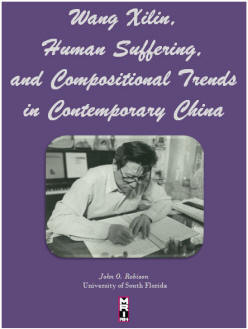|

|
Wang Xilin, Human
Suffering, and Compositional Trends in Contemporary China
by John O. Robison.
Published by the MRI Press 2021
240
pages, ISBN
978-1-933459-10-3 $45.00 per copy plus shipping
Table of Contents
|
Excerpted from Chapters 1 & 11:
“I want to express the suffering of
contemporary people, and the evil of their oppressors.” Once Wang Xilin made
that statement to author John Robison during his first interview in Beijing on
November 10, 2012, he knew that he would need to do something to make Wang and
his music more well-known throughout the world. Described by one German music
critic as one of the most original voices in China, his story is a compelling
one that shows his own personal struggles, as an ordinary person of modest
means, against oppressive ruling powers: Coming from a poor family background,
Wang could not study the music that he wanted to due to government restrictions,
was unjustly treated for fourteen years during the Cultural Revolution, and
could not find his truly distinctive voice as a composer until he was more than
half a century old, after the Chinese government allowed people to have exposure
to the music of twentieth-century European composers such as Stravinsky, Bartok,
Schoenberg, Penderecki, and others….While Wang’s ideas and his talent for
evoking them through music certainly originated from his own experiences within
mainland China, his concern for humanity has gradually evolved into empathy for
all unfairly treated individuals throughout the world. With this universally
appealing message, Wang Xilin deserves recognition as one of most dynamic and
original voices in late twentieth and early twenty-first century music.
Table of Contents
|
Dedication
Publisher’s note
Acknowledgements
Table of Contents
Chapter 1:Biography
Chapter 2: Music for Piano and 23 String Instruments
Chapter 3: Symphony no. 3
Chapter 4: Lamentation I (Shang)
Chapter 5: Symphony no. 4
Chapter 6: Concerto for Violin and Orchestra
Chapter 7: Symphony no. 5
Chapter 8: Symphony no. 6
Chapter 9: Symphony no. 7
Chapter 10: Symphony no. 8
Chapter 11: Concerto for Piano and Orchestra
Chapter 12: Symphony no. 9
Chapter 13: Symphony no. 10
Chapter 14: Conclusion
List of compositions
Bibliography
|
|